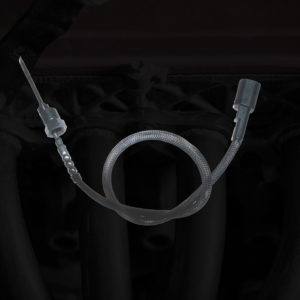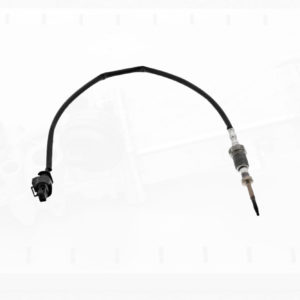The exhaust gas temperature (EGT) sensor plays an important role in controlling the emission levels of a diesel vehicle. It measures how hot the exhaust gases from the engine are before and after they go through the selective catalytic reduction system in the exhaust system. The powertrain control module (PCM) uses the readings from the EGT sensor to adjust the amount of diesel exhaust fluid (DEF) that needs to be added to the exhaust stream.
If the PCM receives a voltage signal from the exhaust gas temperature sensor that indicates an impossibly high temperature, it will log the P2471 code.
What Does the P2471 Code Mean?
The diagnostic trouble code (DTC) P2471 indicates “Exhaust Gas Temperature Sensor Circuit High Bank 1 Sensor 4.”
Exhaust gas temperature sensors (EGT) are a type of resistance temperature detector. When the temperature of the exhaust gas increases, their electrical resistance increases. Conversely, their resistance goes down when the gas gets cooler. They keep track of the temperature of the exhaust gases produced by the engine.

EGT sensors monitor the temperature of the diesel particulate filter (DPF) as a part of “regeneration” timing. Regeneration is the clearing of soot from the DPF, which is done by superheating the particulate filter.
This exhaust temperature sensor feedback signal is used to control regeneration temperature. Three or more EGT sensors may be used, with sensor(s) before the DPF and after the DPF. Make sure you’re working on the right sensor before checking or changing parts.
Some diesel vehicles have a diesel particulate filter that burns particles in the exhaust gas, turning them into harmless substances. Like the catalytic converter in gas vehicles, the DPF needs a certain temperature to work properly.
To increase the temperature of the DPF, the PCM orders the injection of diesel exhaust fluid into the exhaust stream. Along with the reductant catalyst, the sufficiently heated DPF can efficiently get rid of nitrous oxide emissions in the exhaust.
The PCM regularly checks the EGT sensors. If the controller doesn’t get the right response from the number four sensor on bank one, it will set the generic code P2471.
Important Note About Exhaust Gas Temperature Sensors
While code P2471 refers to the exhaust gas temperature sensors measuring exhaust flow into the diesel particulate filter, it’s important to note that some diesel engines will have a different exhaust gas temperature sensor as a part of their EGR systems. This sensor is referred to as an EGR temperature sensor, which is similar in operation, but has a different purpose.

Both the EGR temp sensors and the exhaust gas temp sensors are measuring exhaust temperature, but the platforms using EGR temp sensors measure the temperature of the gas entering the EGR cooler. This type system has an additional sensor measuring exhaust gas temperature as it leaves the EGR cooler. This exhaust gas is directed into the combustion chambers to reduce NOx emissions rather than being sent directly to the diesel particulate filter.
Ford requires a check of engine oil and coolant levels, and the following before checking the sensor or circuit:
- Exhaust leaks at flanges and gaskets
- Punctures or cracks in the catalyst
- Punctures or cracks in the diesel particulate filter
- Engine coolant or oil contamination
Note: The definition of code P2471 can differ according to the vehicle manufacturer. Check the appropriate repair manual or repair database for the exact code definition.
What are the Common Causes of the P2471 Code?
- Faulty EGT sensor
- Bad PCM
- Problems with the EGT sensor wiring

What are the Common Symptoms of P2471 Code?
- Illuminated check engine light
- Vehicle stuck in “limp” mode
How to Diagnose the P2471 Code
The P2471 code can be logged by various makes and models. Despite its prevalence, the specifics of each case may vary according to various factors. A diagnostic and repair process that worked for some vehicles may not apply to other instances of this generic trouble code.
If you’re not confident about conducting diagnostic tests on your vehicle, it’s a good idea to bring it to a professional mechanic. Otherwise, you can go ahead and diagnose the issue yourself.
How to Fix the P2471 Code
Repairing a P2471 code can become a challenging task without the necessary tools and skillset to test the exhaust gas temperature sensor. In most cases, it’s best to take your vehicle to a professional mechanic.
DIYers who do have advanced technical knowledge and hands-on experience can save on labor costs by testing their vehicle’s EGT sensor and replacing the faulty device. It will be helpful to rely on the appropriate repair manual or refer to an online repair database.
Get a Replacement Exhaust Gas Temperature Sensor Without Leaving Your Home
If you encounter trouble codes caused by a faulty exhaust gas temperature sensor, stop using your vehicle until you replace the problematic part. You don’t want to add more exhaust system issues, which might require some of the most expensive repair jobs. Luckily, you don’t have to leave home to get a replacement EGT sensor, thanks to CarParts.com.
Use your phone to access CarParts.com from the comfort of your home and find an exhaust gas temperature sensor that fits your vehicle by entering its –year, make, model, and engine into our vehicle selector. After browsing the search results and picking a part that fits your needs, it only takes several clicks or taps to confirm your order. We only source our products from long-established manufacturers with reliable reputations, ensuring that you get an EGT sensor that lasts a long while and gives excellent performance.
Make CarParts.com your one-stop shop for your car parts needs. Shop for an EGT sensor today.
Any information provided on this Website is for informational purposes only and is not intended to replace consultation with a professional mechanic. The accuracy and timeliness of the information may change from the time of publication.


















